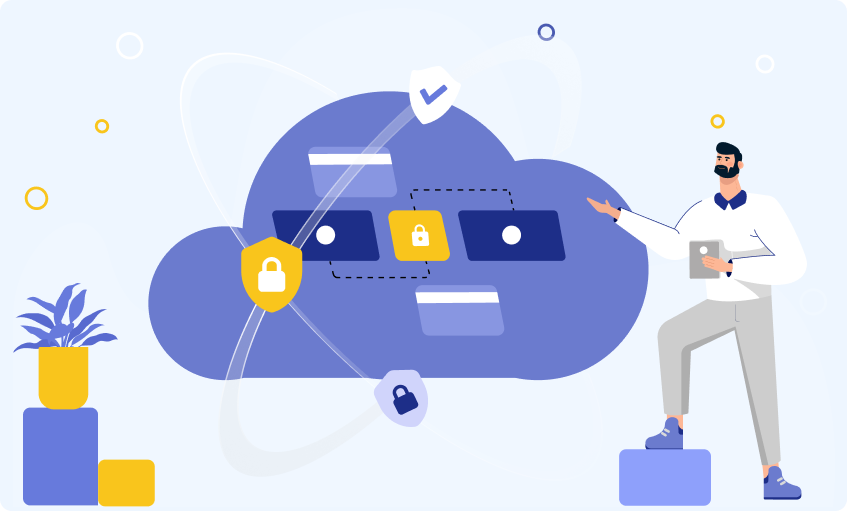Published - a month ago | 7 min read
Integrating AI into Legacy Systems: A Practical View from the Field
Artificial intelligence has quickly become the focus of most digital transformation programs. From predictive analytics in energy to conversational systems in healthcare, the promise is clear: smarter operations, faster decisions, and new business opportunities. But for many enterprises, the road to AI runs through old systems that were never designed to host or even connect with modern algorithms.
Legacy systems still run banking back offices, hospital scheduling platforms, and government record systems. These environments are stable, proven, and in many cases decades old. They also carry serious limitations. Performance bottlenecks, rigid data formats, and siloed databases all complicate any attempt to add intelligence.
The question is not whether organizations should modernize these systems. The real question is how to do it without disrupting business continuity, losing critical data, or spending years in a complete rebuild. What follows is not a glossy framework. It is a practical exploration of what it takes to integrate AI into legacy environments, built on the realities of enterprise IT.
Legacy systems still run banking back offices, hospital scheduling platforms, and government record systems. These environments are stable, proven, and in many cases decades old. They also carry serious limitations. Performance bottlenecks, rigid data formats, and siloed databases all complicate any attempt to add intelligence.
The question is not whether organizations should modernize these systems. The real question is how to do it without disrupting business continuity, losing critical data, or spending years in a complete rebuild. What follows is not a glossy framework. It is a practical exploration of what it takes to integrate AI into legacy environments, built on the realities of enterprise IT.
Looking at Legacy Before Adding Intelligence
Every modernization program begins with an honest look at what is already there. Too often, organizations rush into pilots with cloud AI services without first examining whether their existing platforms can support the load.
Legacy systems are diverse. A regional bank may still operate COBOL applications on mainframes. A manufacturer might run critical processes on ERP versions that were last updated fifteen years ago. Utilities may depend on SCADA systems with proprietary protocols.
Each of these environments poses different challenges. Performance ceilings, rigid data models, and limited connectivity are the most common. Security is another. Older systems often lack modern access controls or encryption. Before any AI project begins, these realities have to be acknowledged.
CIOs I’ve worked with often use a simple rule of thumb: if a system cannot scale, cannot interoperate, or cannot be secured, it cannot be part of the AI future in its current form. That doesn’t always mean replacement. Sometimes it means building a protective layer around the old system to extract value without opening it up to unnecessary risk.
Legacy systems are diverse. A regional bank may still operate COBOL applications on mainframes. A manufacturer might run critical processes on ERP versions that were last updated fifteen years ago. Utilities may depend on SCADA systems with proprietary protocols.
Each of these environments poses different challenges. Performance ceilings, rigid data models, and limited connectivity are the most common. Security is another. Older systems often lack modern access controls or encryption. Before any AI project begins, these realities have to be acknowledged.
CIOs I’ve worked with often use a simple rule of thumb: if a system cannot scale, cannot interoperate, or cannot be secured, it cannot be part of the AI future in its current form. That doesn’t always mean replacement. Sometimes it means building a protective layer around the old system to extract value without opening it up to unnecessary risk.
Data: The First Roadblock
Every conversation about AI quickly turns into a conversation about data. Models are trained on it, decisions are validated against it, and outcomes are measured through it. In legacy systems, data is usually the weakest link.
Files are stored in outdated formats. Records are duplicated. Key identifiers are missing. Access rights are inconsistent. In one insurance client I worked with, claims data was spread across four separate mainframe systems. Each used a different customer ID schema. Trying to train fraud detection models on that data was impossible until months of data reconciliation were completed.
This is where organizations often underestimate the effort required. Cleaning and standardizing legacy data is not glamorous work, but it is the foundation for AI success. Without it, models produce biased, unreliable, or even dangerous results.
Modernization teams that succeed here usually build pipelines that continuously clean and standardize incoming data rather than treating it as a one-off project. APIs and middleware become critical, acting as translators between old formats and modern AI-ready structures.
Files are stored in outdated formats. Records are duplicated. Key identifiers are missing. Access rights are inconsistent. In one insurance client I worked with, claims data was spread across four separate mainframe systems. Each used a different customer ID schema. Trying to train fraud detection models on that data was impossible until months of data reconciliation were completed.
This is where organizations often underestimate the effort required. Cleaning and standardizing legacy data is not glamorous work, but it is the foundation for AI success. Without it, models produce biased, unreliable, or even dangerous results.
Modernization teams that succeed here usually build pipelines that continuously clean and standardize incoming data rather than treating it as a one-off project. APIs and middleware become critical, acting as translators between old formats and modern AI-ready structures.
Security and Compliance Considerations
Adding AI to legacy systems is not only a technical challenge but also a regulatory one. Legacy environments are often built on outdated security assumptions. Introducing AI models that connect to sensitive data without tightening security is a recipe for non-compliance.
Healthcare providers integrating AI for diagnostics face HIPAA constraints. Financial institutions deploying predictive models face Basel and GDPR scrutiny. Energy operators must align with strict safety and resilience rules.
In every case, AI adoption forces organizations to revisit how data is encrypted, who has access, and how audit trails are recorded. Modern monitoring tools can help, but only if they are integrated carefully into older infrastructure. This is where governance becomes just as important as algorithms.
Healthcare providers integrating AI for diagnostics face HIPAA constraints. Financial institutions deploying predictive models face Basel and GDPR scrutiny. Energy operators must align with strict safety and resilience rules.
In every case, AI adoption forces organizations to revisit how data is encrypted, who has access, and how audit trails are recorded. Modern monitoring tools can help, but only if they are integrated carefully into older infrastructure. This is where governance becomes just as important as algorithms.

The Modular Path
One misconception about AI integration is that the only way forward is a full-scale replacement of legacy systems. In practice, the most effective strategy is usually modular.
Rather than rewriting the entire stack, AI capabilities are added as surrounding services. For example, an AI-driven recommendation engine may sit outside the core ERP but connect through APIs. A predictive maintenance system may process IoT sensor data separately before sending results back to the plant’s legacy control system.
This modular approach reduces disruption. It also allows organizations to experiment with smaller, high-impact use cases without committing to massive replatforming.
In oil and gas, one operator introduced predictive maintenance AI to aging drilling platforms. Instead of replacing the SCADA systems, they built a middleware layer that collected sensor data, ran AI models in the cloud, and fed back alerts in formats the legacy system could accept. The result: a 20% reduction in downtime without touching the control software itself.
Rather than rewriting the entire stack, AI capabilities are added as surrounding services. For example, an AI-driven recommendation engine may sit outside the core ERP but connect through APIs. A predictive maintenance system may process IoT sensor data separately before sending results back to the plant’s legacy control system.
This modular approach reduces disruption. It also allows organizations to experiment with smaller, high-impact use cases without committing to massive replatforming.
In oil and gas, one operator introduced predictive maintenance AI to aging drilling platforms. Instead of replacing the SCADA systems, they built a middleware layer that collected sensor data, ran AI models in the cloud, and fed back alerts in formats the legacy system could accept. The result: a 20% reduction in downtime without touching the control software itself.
Choosing the Right Use Cases
Not every process is a candidate for AI. Choosing where to begin is critical. The sweet spot lies in use cases that combine high business value with manageable technical complexity.
Fraud detection in financial services, predictive maintenance in manufacturing, demand forecasting in retail, and personalized recommendations in e-commerce all fall into this category. They leverage data that is already being collected and produce measurable outcomes.
Organizations that start with high-risk, low-reward projects—like full-scale core banking AI transformations—often stall. Those that start with well-defined, modular use cases build momentum and credibility that allows them to expand later.
Fraud detection in financial services, predictive maintenance in manufacturing, demand forecasting in retail, and personalized recommendations in e-commerce all fall into this category. They leverage data that is already being collected and produce measurable outcomes.
Organizations that start with high-risk, low-reward projects—like full-scale core banking AI transformations—often stall. Those that start with well-defined, modular use cases build momentum and credibility that allows them to expand later.
Collaboration Between IT and AI Teams
AI experts and IT operations teams often come from different worlds. Data scientists are focused on experimentation and accuracy. IT professionals prioritize stability, uptime, and security.
Bringing these groups together is one of the biggest cultural hurdles in AI integration. Without it, models remain stuck in proof-of-concept while operations resist deployment. Successful programs establish joint teams, shared roadmaps, and clear decision rights early.
In one retail project, IT insisted on strict access controls while data scientists pushed for open datasets. The compromise was a controlled sandbox environment that gave data scientists flexibility while maintaining governance. It slowed the initial phase but made later deployment much smoother.
Bringing these groups together is one of the biggest cultural hurdles in AI integration. Without it, models remain stuck in proof-of-concept while operations resist deployment. Successful programs establish joint teams, shared roadmaps, and clear decision rights early.
In one retail project, IT insisted on strict access controls while data scientists pushed for open datasets. The compromise was a controlled sandbox environment that gave data scientists flexibility while maintaining governance. It slowed the initial phase but made later deployment much smoother.

Scaling AI Beyond Pilots
Many organizations succeed with pilots but struggle to scale. A chatbot may work well for one department, but extending it enterprise-wide requires integration with HR, IT, and finance systems. Predictive maintenance may succeed on a single plant line, but scaling it across ten plants requires standardized data pipelines, training, and support processes.
Scaling AI in legacy environments requires three things:
1. Reliable monitoring to track model performance and prevent drift.
2. Automated deployment pipelines to update models as data evolves.
3. Clear ownership of who maintains models and ensures compliance.
Without these, pilots remain isolated experiments rather than enterprise capabilities.
Scaling AI in legacy environments requires three things:
1. Reliable monitoring to track model performance and prevent drift.
2. Automated deployment pipelines to update models as data evolves.
3. Clear ownership of who maintains models and ensures compliance.
Without these, pilots remain isolated experiments rather than enterprise capabilities.
AI at the Edge
Not all AI has to live in the cloud. In industries like manufacturing, healthcare, and energy, edge AI—running models on local devices—has become critical. It reduces latency, preserves bandwidth, and keeps sensitive data local.
Consider a hospital radiology department. Uploading every scan to the cloud for AI analysis is inefficient and raises compliance concerns. Running models directly on imaging devices or local servers delivers faster results and keeps patient data secure.
Integrating edge AI into legacy systems can be less invasive too. Instead of overhauling central hospital IT, AI modules are added closer to the source of the data.
Consider a hospital radiology department. Uploading every scan to the cloud for AI analysis is inefficient and raises compliance concerns. Running models directly on imaging devices or local servers delivers faster results and keeps patient data secure.
Integrating edge AI into legacy systems can be less invasive too. Instead of overhauling central hospital IT, AI modules are added closer to the source of the data.
Measuring ROI the Right Way
Enterprises often treat AI ROI as a one-dimensional measure: cost saved or revenue generated. In reality, the return from AI in legacy systems includes softer but equally critical factors—reduced downtime, faster decision cycles, improved compliance, and higher employee satisfaction.
One healthcare network found that clinicians using AI-driven documentation tools spent 61% less time on administrative tasks. The immediate ROI was time saved. The deeper ROI was improved patient care, better clinician morale, and reduced turnover costs.
Measuring these outcomes requires patience and a willingness to look beyond quarterly financials. But without that discipline, AI programs risk being undervalued or prematurely abandoned.
One healthcare network found that clinicians using AI-driven documentation tools spent 61% less time on administrative tasks. The immediate ROI was time saved. The deeper ROI was improved patient care, better clinician morale, and reduced turnover costs.
Measuring these outcomes requires patience and a willingness to look beyond quarterly financials. But without that discipline, AI programs risk being undervalued or prematurely abandoned.
The Strategic Role of AI in Legacy Modernization
AI is not just a tool for optimization. When applied well, it changes the trajectory of entire organizations.
In mergers and acquisitions, TCO and AI readiness are now part of due diligence. Investors want to know how much technical debt a target carries and whether its systems can support AI-driven efficiencies.
In fundraising, companies with credible AI integration stories are more attractive. They demonstrate not only innovation but also financial sustainability.
In product strategy, high TCO can prevent pivots. AI that reduces ongoing costs frees up resources for experimentation. It creates room to innovate without sacrificing stability.
In mergers and acquisitions, TCO and AI readiness are now part of due diligence. Investors want to know how much technical debt a target carries and whether its systems can support AI-driven efficiencies.
In fundraising, companies with credible AI integration stories are more attractive. They demonstrate not only innovation but also financial sustainability.
In product strategy, high TCO can prevent pivots. AI that reduces ongoing costs frees up resources for experimentation. It creates room to innovate without sacrificing stability.
The Human Element
No AI integration succeeds without people. Training, adoption, and change management are as important as algorithms. Employees need to understand how AI impacts their work. Stakeholders need reassurance that governance remains intact.
This is often the hardest part of modernization. Technology can be purchased. Trust has to be earned. Organizations that invest in training, transparent communication, and shared ownership of AI outcomes see far higher adoption than those that treat AI as a black box.
This is often the hardest part of modernization. Technology can be purchased. Trust has to be earned. Organizations that invest in training, transparent communication, and shared ownership of AI outcomes see far higher adoption than those that treat AI as a black box.
Conclusion
Integrating AI into legacy systems is not about ripping and replacing everything that came before. It is about connecting the proven with the new, in ways that respect existing investments while unlocking new value.
The path is rarely linear. Some systems will need replacement. Others can be augmented. All will require careful attention to data, security, and governance. Enterprises that succeed treat AI not as a bolt-on but as a capability woven into the broader modernization story. They start small, prove value, and scale with discipline. They balance ambition with pragmatism. The prize is significant: smarter operations, lower costs, happier employees, and more competitive businesses. Legacy systems may have been built for another era, but with thoughtful integration, they can become part of an intelligent future.
The path is rarely linear. Some systems will need replacement. Others can be augmented. All will require careful attention to data, security, and governance. Enterprises that succeed treat AI not as a bolt-on but as a capability woven into the broader modernization story. They start small, prove value, and scale with discipline. They balance ambition with pragmatism. The prize is significant: smarter operations, lower costs, happier employees, and more competitive businesses. Legacy systems may have been built for another era, but with thoughtful integration, they can become part of an intelligent future.

Written by / Author
Manasi Maheshwari
Found this useful? Share With
Top blogs
Most Read Blogs
Wits Innovation Lab is where creativity and innovation flourish. We provide the tools you need to come up with innovative solutions for today's businesses, big or small.
© 2025 Wits Innovation Lab, All rights reserved
Crafted in-house by WIL’s talented minds

